Lip Blushing vs. Fillers: Choosing The Best Treatment For You
Lip Blushing vs. Fillers: Choosing The Best Treatment For You
If you’re longing for fuller, more defined lips, the thought of trying out temporary lip enhancements has probably crossed your mind. Two popular treatments worth considering are lip blushing and lip fillers. Both non-surgical options are safe, effective and provide final results within a few weeks. Lip blushing has become a popular alternative to lip fillers in recent years due to its shorter healing time, longevity, and more natural results. However, both procedures have a purpose – depending on your desired look and tolerance for regular upkeep.
Lip blushing and fillers can also be used together to enhance your results. However, it is important to schedule your lip blushing session at least 6 months before a lip filler appointment. Wait at least 2 weeks after lip blushing to get any additional lip injections or fillers. Following these guidelines will ensure that there’s enough time for your lips to recover in-between procedures. It is recommended to get lip blushing done before injecting filler when possible.
Read on to learn everything you want to know about lip blushing and lip fillers, how to choose which option is right for you, what to expect before and after lip blushing (or fillers), proper after-care practices to follow, and more.

What is Lip Blushing?
Lip blushing is a semi-permanent makeup, cosmetic tattooing procedure that involves injecting pigment into the lips with tiny needles. This PMU treatment offers many colour-correcting benefits, from lip neutralizing (to resolve uneven lip tone or scar pigmentation) to customizing your lip shade (like a permanent lipstick) and enhancing pale or aging lips. Lip blushing creates a more defined lip shape and makes them more symmetrical. This enhanced definition from lip blushing makes your lips appear fuller without physically adding volume to the area.
Discover here what you should know before getting a lip blushing tattoo.
What is Lip Filler?
Lip fillers are injectable dermal fillers that add volume and plump your lips. The most common types of lip fillers used today are hyaluronic acid fillers (replacing once-popular collagen fillers). Hyaluronic acid is a naturally-occurring substance in the body responsible for keeping your skin, eyes, hair, and connective tissues hydrated. It binds with collagen to leave your skin softer, more supple, and nourished, and offers many benefits when applied topically, ingested, or injected.
Some benefits of hyaluronic acid include its anti-aging effects, skin hydration, improved skin elasticity, and accelerated wound-healing. As injectables, hyaluronic acid lips fillers are known to be highly durable and effective in improving lip plumpness with minimal to no bruising.
Other benefits of hyaluronic acid fillers include dose flexibility over time and has a low risk of an allergic reaction. This customization makes it easy to control the levels of lip volume created or dissolve bumps if the filler doesn’t settle properly while healing.
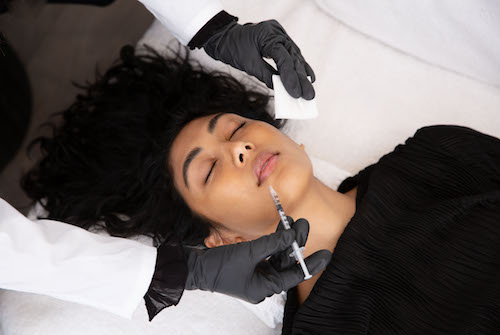
Lip Blushing vs. Lip Fillers Results
Immediately after lip blushing, the colour will be the most pigmented and significantly more vibrant than your final results. Final results from lip blushing should appear around 4-6 weeks after your initial appointment and will be around 30-50% lighter than the colour you saw in the mirror right after completing your session. A follow-up consultation should be scheduled 6-8 after this first session. At this second appointment, your artist can touch up your lips to ensure you end up with your desired results. Lip blushing tattoos last for around 2-3 years. The rate at which the pigment and definition fade over time depends on your skin type, sun exposure, skincare routine, diet, and lifestyle habits.
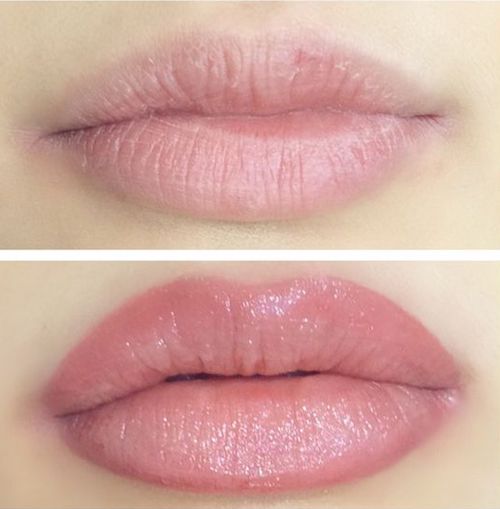
Credit: InStyle/Pinterest
Results from lip fillers are visible immediately. However, you will start seeing the final results around 2 weeks after your injections. Some hyaluronic acid fillers take up to 6-8 weeks to settle. Lip fillers typically last for around 6-12 months, depending on the type you get injected. Common hyaluronic acid lip fillers, like Juvederm and Restylane, can last anywhere from 3 months to 2 years before they dissolve. The longevity of lip fillers greatly differs from person to person.
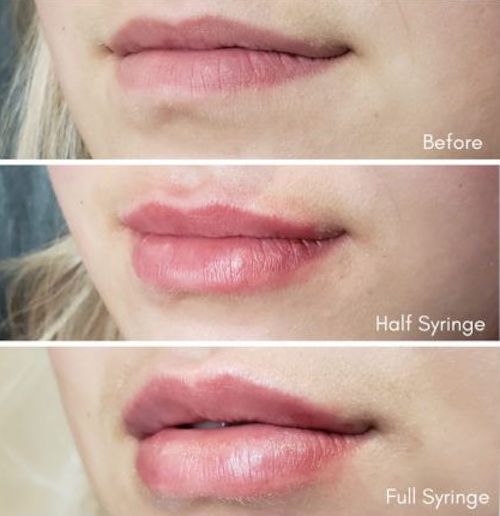
Credit: The Luxe Room/Pinterest
Lip Blushing vs. Lip Fillers Healing Time
Lip blushing tattoos take around 4-6 weeks to fully heal. The initial healing process (swelling, flaking, and peeling) should subside after around 10-14 days. After these first healing stages, your lip blushing colour might briefly “disappear” while the skin thickens and scabs cover the pigment. The colour should “reemerge” after 1-2 weeks with the resulting pigment colour. Here’s everything you need to know about the lip blushing healing process.
Lip fillers take between 1-2 weeks to fully heal. The pain should subside within 24 hours. Swelling should go down around 48 hours after the procedure, but this process can take up to a few days. Lip fillers fully settle in around 2-4 weeks, depending on the type of dermal filler used.
Lip Blushing vs. Lip Fillers Pain
A common concern with lip blushing or filler is whether they will hurt. And if so, how painful will these procedures be? While the lips are a naturally sensitive area, both of these treatments rate fairly low on the pain scale thanks to the lidocaine used during the session – either in a numbing cream applied beforehand or inside the injectable itself. While pain is subjective, these pain scale rankings are based upon a general consensus.
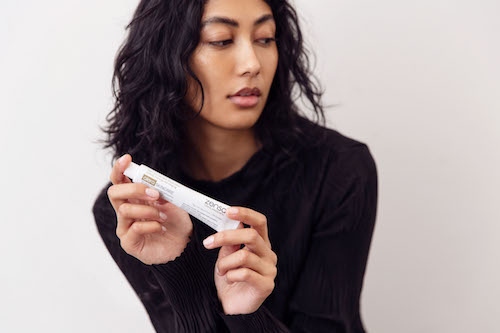
Lip blushing typically rates at around a 2-4/10 on the pain scale. Your expert should apply a numbing cream, like Zensa Numbing Cream, before lip tattooing. Zensa Numbing Cream contains 5% lidocaine (maximum strength) with a natural PH formulation to cater to sensitive areas, like the lips, and does not contain any vasoconstrictors that prevent ink from properly settling. The numbing cream should be left on for around 20 minutes before the lip blush procedure begins. Once the lidocaine takes effect, most clients experience minimal pain that they describe as slight pinching or minor scratching.
Lip fillers also are not considered to be too painful and rank at a 2-4/10 on the pain scale. With numbing cream, the procedure will likely feel like small scratches with a slight burning sensation. Some injectables contain lidocaine in the syringe to help block the pain during the procedure. (Juvederm and Restylane both contain small amounts of lidocaine.) For additional pain reduction, your expert can apply an anaesthetic cream, such as Zensa Numbing Cream, approximately 15-20 before injecting your lips to make the short-lived experience nearly pain-free.

Lip Blushing vs. Lip Fillers Preparation
Preparation guidelines for lip blushing and lip fillers are highly similar. You will need to avoid most of the same products and ingredients within different timelines for each procedure. However, there are more restrictions to keep in mind before getting a lip blushing tattoo than before a lip filler appointment. Make sure to never show up to a lip blushing or filler appointment with cold sores or flaky, chapped lips.
How To Prepare For Lip Blushing
Avoid getting facials, chemical peels, microdermabrasion treatments, or using vitamin A-containing skincare, such as Retin-A or retinol, for at least 4 weeks before lip blushing. Two weeks before your appointment, stop using any anti-aging, anti-acne, chemical exfoliation (AHA) products. Avoid direct sun exposure, tanning, sweating, swimming, or saunas for 2-4 weeks before lip blushing.
Stop using any blood-thinning medications at least 48 hours before your appointment. Medications to avoid include NSAIDs, like Motrin, Ibuprofen, and Aleve, or supplements, such as Vitamin E, garlic tablets, turmeric, ginseng, and ginkgo biloba, among others. Some experts recommended avoiding these blood-thinning products for up to 7 days before lip blushing.
Avoid drinking alcohol and caffeine for at least 24-48 hours before your appointment. These products have blood-thinning qualities and dehydrate the skin, which can lead to poor pigment retention. Exfoliate and hydrate your lips for a few nights before your appointment using a lip scrub and a moisturizing balm. This routine is especially important the night before your lip blushing session.

How To Prepare For Lip Fillers
Avoid taking any blood-thinning medications, such as the NSAIDs (Motrin, Ibuprofen, and Aleve) and supplements, like Vitamin E, garlic tablets, turmeric, ginseng, and ginkgo biloba. Remove skincare products containing Retin-A, retinol, glycolic acid, and other anti-aging ingredientsfrom your routine at least 48 hours before your lip filler appointment. Avoid hair removal practices, including waxing, tweezing, or using hair removal creams for at least 2 days before lip filler is injected.
Stop drinking alcohol or caffeine at least 24-48 hours before a lip filler appointment. These products can increase swelling, bleeding, and bruising.
What To Expect During A Lip Blushing Session
The entire lip blushing session should take approximately 60-90 minutes. First, you will meet with your expert to select a pigment colour. Remember that lip blushing will only change your lip tone by around 1-2 shades, so choosing a natural “your lips but better” colour will be the most versatile (and flattering) for everyday wear. You can always apply lipstick or gloss over the pigment once it’s fully healed. The cosmetic tattoo artist will guide you through the colour selection process before custom-mixing your perfect shade.
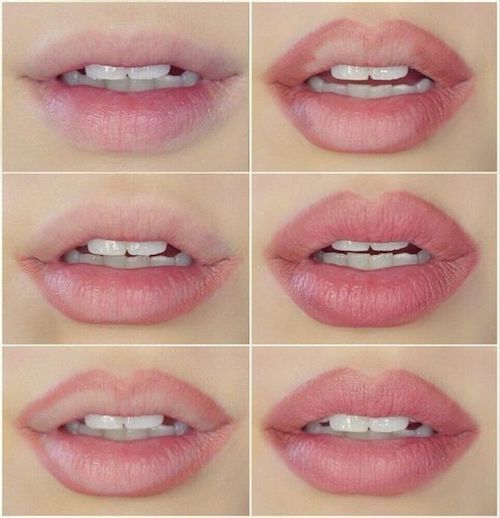
Credit: Sephora/Pinterest
Once your desired colour is crafted, your expert will outline your newly-defined lip shape with a lip liner or lipstick before going in with the mechanical needle device. The artist will then apply some numbing cream and leave it on for around 20 minutes before beginning the procedure.
What To Expect During A Lip Filler Session
The lip filler appointments should take around 45 minutes from start to finish. Be prepared to do an intake outlining any medical history or medication use. Once your forms are completed, your expert will do a consultation with you to observe the shape of your lips, how your mouth moves, and discuss how you want your pout to look post-lip augmentation. Next, the aesthetic practitioner will apply a numbing cream to your lips and let it sit for around 20 minutes. Once the numbing effects kick in, the procedure will begin. Lip fillers should take only around 10-15 minutes to inject.

Lip Blushing After-Care
The pigment colour will appear the most vibrant immediately after the lip blushing treatment ends. Expect some swelling, minor bleeding, bruising, swelling, lip tenderness, and dryness for the first 24-72 hours. Like with any tattoo, proper after-care is essential for wound-healing, ink fading prevention, and reducing the chances of irritation or infection. Carefully follow your expert’s after-care instructions. We’re sharing some general best lip blushing after-care practices to support the healing process.
Around 4 hours after your lip blushing session, blot your lips with a clean paper towel to remove any lymph fluid. Then apply a moisturizing after-care product, like Zensa Healing Cream or Aquaphor, to keep your lips hydrated. Wash your lips twice a day with a gentle, fragrance-free cleanser and lukewarm water. Pat them dry with a fresh paper towel. Follow up with your hydrating after-care product. Use an after-care moisturizer as needed throughout the day (apply a thin layer each time), especially at night and after meals. Keeping your lips hydrated is especially important during these initial healing stages.
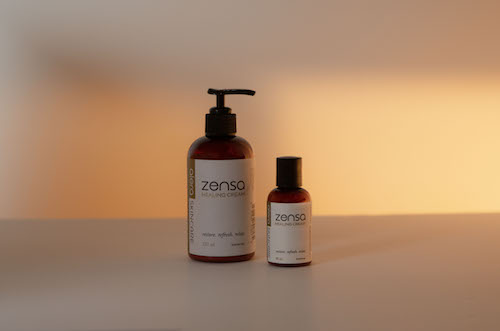
Avoid any sweat-inducing or skin-irritating activities, like high-intensity exercise, saunas, swimming, hot showers, eating spicy foods, kissing, direct exposure, or wearing lip cosmetics for the first 10 days after lip blushing.

Credit: PMUHub/Pinterest
Lip Filler After-Care
Lip swelling, bruising, and dryness are all common side effects immediately after getting lip filler. Make sure to drink plenty of water and eat a diet rich in fruits and vegetables to stay hydrated, especially for the first 24 hours after your appointment. Don’t consume hot and spicy foods or drinks right after getting filler. Apply an ice pack or bag of frozen vegetables on your lips to reduce swelling. Elevate your head and sleep on your back or the first night or two.

Credit: LINZ Aesthetics/Pinterest
Avoid intense exercise, blood-thinning medications, swimming, or kissing for the first 48 hours. Don’t drink alcohol or lip cosmetics for at least 24 hours after getting filler. Always open a new lip product (like a lip balm or lipstick) to use right after lip filler. Avoid using older makeup products on your lips until they’ve fully healed.
It is recommended to avoid flying, attending an event, or getting laser treatments and similar cosmetic procedures for at least 2 weeks after getting lip filler. Plan your social calendar accordingly.
Lip Blushing Over Lip Fillers: Which Should You Choose?
Lip blushing and fillers offer different results, so the pros and cons should be weighed, depending on your preferences and desired look. Lip fillers can hydrate your lips and provide volume and anti-aging rejuvenation that lip blushing cannot replicate.
However, if you’re concerned about swelling and leaving your session with comically-large lips, consider lip blushing as a more natural-looking alternative to filler. Lip blushing is less invasive and easier to correct or touch up if you aren’t completely satisfied with the initial results. The healing process for lip blushing tends to be shorter than the recovery time for lip filler. However, your healing time for each procedure will differ, depending on the individual.
Use the right prep and after-care products to give your lips the gift of a more luscious look with less pain – regardless of the procedure you choose.
